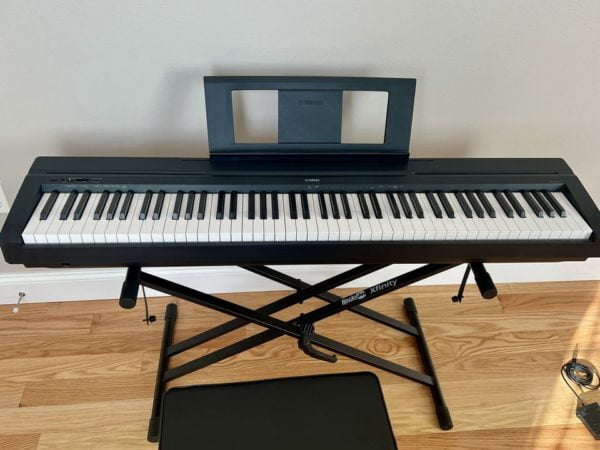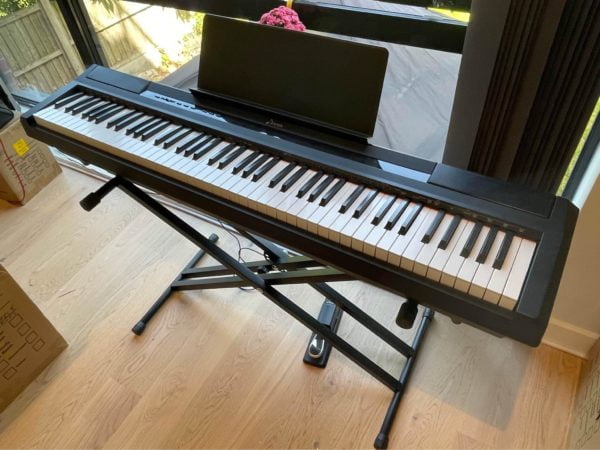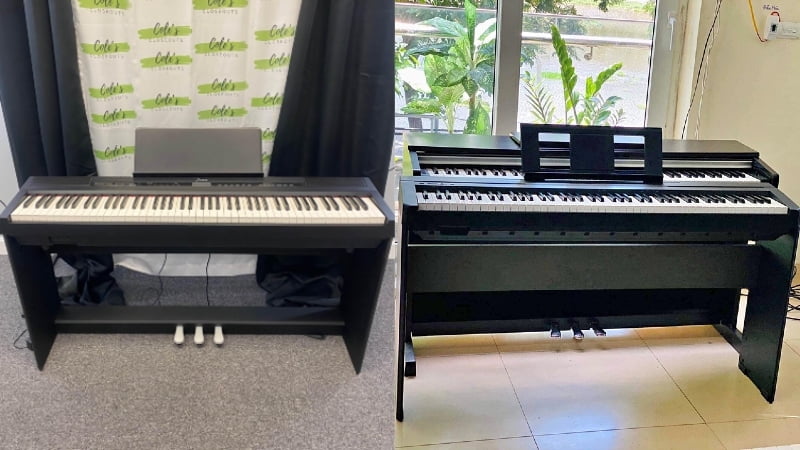Find out which piano is the best option for beginners in this Donner DEP-10 Vs Yamaha P-45 comparison.
When I checked out these two models, I found that both had their ups and downs. And after careful comparison and consideration, I found that the Yamaha P45 wins out in the Donner DEP-10 vs Yamaha P-45 comparison.
Why so, you ask?
While it is the more expensive option the Yamaha P-45 also has much more flexibility and versatility. The piano comes with a rich set of voices that are suited for novices and beginners alike while also having a better hammer action system and feel overall.
With that said, don’t discount the Donner DEP-10 either. This model, while it is entry-level, offers a bunch of functionality and a surprising set of features. And if you’re a beginner trying to learn the basics, the Donner DEP-10 could still serve you incredibly well.
Donner DEP-10 vs Yamaha P-45: Comparison Chart


Last update on 2025-06-28 / Affiliate links / Images from Amazon Product Advertising API
Donner DEP-10 vs Yamaha P-45: The Features
Whenever I compare two pianos, I find it easier to look at each of the features individually. That way, it’s much easier to choose an objective winner.
And when comparing the DEP-10 against the P-45, the Yamaha P-45 eventually won. The final score between the two was 3-1 in favor of the Yamaha because of superior feel and tone generation.
However, the DEP-10 did put up a fair fight and was even able to tie the Yamaha P-45 in terms of piano features, which is no easy feat, considering the DEP-10 is way cheaper than the Yamaha P-45.
Tone
The winner: Yamaha P-45
It can be hard to compare the tones of different pianos, since this is a very subjective area. However, when testing out these pianos the Yamaha P-45 won out because of the more sophisticated tone generation system and the extra voices loaded into the sound library.
+Tone Generation
Both of these pianos use some sort of sampling method for their tones. However, the Donner DEP-10 features a more classic and traditional approach to sampling. It has fairly high-quality samples that produce decent tones, though there is a definite “digital” texture to the sounds on the Donner DEP-10.
On the flip side, the Yamaha P-45 uses the AWM Sampling Method. This is a method reserved for many Yamaha pianos, and it uses much more detailed samples compared to the other options on the market.
By loading high-quality stereo samples into the Yamaha P-45, they were able to get a much more realistic tone. On top of that, since Yamaha manufactures some of the most famous grand pianos on the market, they were able to collect their samples directly for their instrument.
And the end result was a much richer, vibrant, and realistic tone on the P-45, especially when compared to the Donner DEP-10.
+Sound Library
The Yamaha P-45 has 10 different tones in the sound library. While this isn’t a lot, it is more than the Donner DEP-10, which only has 8.
Generally, digital pianos aren’t loaded with a lot of different voices. The reason for this is that digital pianos are more focused on quality rather than quantity. So, it’s actually a surprise that the relatively affordable Yamaha P-45 comes with 10 different high-quality piano voices.
The Donner DEP-10 has a fairly decent sound library with enough variety for most beginners and novices. However, it would have been nice if you had as many choices as you do on the Yamaha P-45, which gives you much more control over the tone and sound of your piano.

Feel & Playability
The winner: Yamaha P-45
The Donner DEP-10 only comes with semi-weighted keys. This is fine for a beginner’s piano, but since the Yamaha P-45 came with the GHS weighted hammer system, it easily beat out the Donner DEP-10 in terms of feel and playability.
+Hammer Action
In the world of digital pianos, the Yamaha Graded Hammer Standard or GHS is one of the highly coveted hammer action systems out there. These aren’t just fully-weighted keys. Instead, the keys on the Yamaha P-45 are noticeably heavier on the left side before getting significantly lighter on the right side.
This mimics the slight hammer action differences on an acoustic piano, and provides a much more realistic feel. If you’re a beginner, you may not notice or enjoy the GHS since a lot of beginners find it hard to press down on keys with heavy hammer action.
This is why the Donner DEP-10 is largely considered a great piano for children and beginners. Since it only has semi-weighted keys, it is lighter on the fingers, making it easier to learn the basics.
However, you sacrifice a whole lot of realism when it comes to the feel on the Donner DEP-10, and that is the main reason I found that the Yamaha P-45 has superior feel.
Piano Features
The winner: Tie
Since the Yamaha P-45 is the more expensive option, this is the one category where I expected it to blow the Donner DEP-10 out of the park. But to my surprise, the Donner DEP-10 held its own in almost every piano feature that the P-45 offered. So, at the end of this comparison, I found that these two pianos were tied in terms of piano features.
+Playing Modes
At first glance, you might think that the Yamaha P-45 has better playing modes than the DEP-10. However, after careful consideration, I found that both pianos have a set of playing modes that can benefit different pianists.
The only additional playing mode on the DEP-10 is recording mode. With this mode, you can record your playing, listen back on it, then take notes on where you can make improvements. If you’re a beginner, this is incredibly valuable as it allows you to listen and critique your own playing based on your own tastes.
This mode isn’t available on the Yamaha P-45. However, the Yamaha P-45 does come with lesson and layering mode, which are equally as useful. With lesson mode, you divide the piano into two equal keyboards, which allows the teacher and student to play along at the same time, making for a smoother learning process.
With layering mode, you can trigger two separate voices on the piano at the same time. This is an incredibly useful feature for people looking to come up with a tone that is uniquely theirs.
Since both pianos offer an array of different features, the better option largely depends on your priorities. If recording and listening to your playing afterwards is important for you, then the DEP-10 will serve you better. If you’re looking for layering and lesson mode, then the P-45 might just be your best pick.

+Polyphony
I was surprised to find that the Yamaha P-45 only has 64-note polyphony. While this is enough to handle most beginner pieces and songs, it is admittedly limiting. I was even more surprised later on to learn that the Donner DEP-10 has 128 note maximum polyphony, double that of the Yamaha P-45.
This gives it a whole lot of functionality. With the DEP-10, you can play more notes at a time. For beginners, this isn’t really a big deal. However, it’s better to not need the feature and have it rather than need the feature and not have it.
While most basic piano pieces start with single notes and less dense chords, as you progress, you will need higher maximum polyphony, which the DEP-10 can easily provide.
+Effects
Both of these pianos come with reverb. They don’t come with any additional effects, which is completely fine since reverb is the most common effect you’ll use as a pianist anyway.
And when testing out the reverb effects of both instruments, I found that the Yamaha P-45 had slightly higher-quality and more realistic reverb. However, it wasn’t enough to be a glaring difference, so these two pianos are still tied in terms of piano features.
Donner DEP-10 vs Yamaha P-45: The Similarities
These are two beginner digital pianos. And while they have different hammer action systems, they do have very similar keys. Both these pianos feature plastic glossy keys which do not mimic the texture and feel of an acoustic piano at all.
Is this a big deal? Well, not really.
However, it would have been nice if any of these options featured some sort of coating to add another dimension of realism to the pianos. But since that is not present, I found that to be a knock on the quality of both options.
That isn’t the only similarity these pianos share. They are both 88-key keyboards that give you the full range of an acoustic piano. This is arguably the most important feature of any digital piano, and it’s why either of these options would make a great pick for just about any beginner out there.
But at the end of the day, I had to choose a winner. Now, don’t get me wrong. I love the Donner DEP-10 and all the functions it offers at a very affordable price. However, the hammer action system and tone generation of the Yamaha P-45 is almost second to none in its price range, which is why I found it to be the better investment.
Quick Rundown of the Donner DEP-10
- 🥇【Full-sized 88 Semi-weighted Keys】Donner DEP-10 digital piano features 88 semi-weighted keys that simulate the real touch of playing a piano. Semi-weighted keys reduce the sense of strength than full-weighted keys for more sensitive touch response to suit different playing styles, provide greater control, and maximizes playing comfort.
- 🥇【8 Excellent Tones&128 Polyphony】DEP-10 88-key electric piano can switch between the sounds of eight different instruments, include Acoustic Piano, Electric Grand Piano, Church Organ, etc. And it can also play two tones at the same time( Dual Tone Setting Function). With 128 polyphony, digital piano can provide super clear rendition, natural feeling of different sounds , perfect for teaching and learning.
- 🥇【Superior Sound Quality】Equipped with two built-in 25W speakers, a sustain pedal, audio input and output, and an MP3 player. DEP-10 delivers a rich and immersive practice and performance experience for players.
- 🥇【Versatile Instrument】You can control the rhythm with diffrent four types of metronome beats. The effects can select from trill, suspension, and DSP. Meanwhile, you can record and arrange your music with the recording mode. DEP-10 is good for players’ different demands and allows you create complex songs with ease.
- 🥇【Modern Sleek Design】The streamlined piano body and textured keys of the DEP-10 88-key digital piano provide an extraordinary playing experience. Beginners can enjoy the beauty of music with this well-designed instrument.
Last update on 2025-06-28 / Affiliate links / Images from Amazon Product Advertising API
Quick Rundown of the Yamaha P45
- Includes the P45 Digital Piano, power adapter, sustain pedal and music rest
- 88 fully weighted piano style keys simulate the feel of an acoustic piano and provide a quality playing experience
- GHS weighted action is heavier in the low end and lighter in the high end, just like an acoustic piano
- Contains 10 different voices, including digitally sampled tones from real Yamaha acoustic grand pianos
- Dual mode lets you combine 2 voices together, like piano and strings, for an inspiring new playing experience. Tuning- 414.8 - 440.0 - 446.8 Hz
Last update on 2025-06-28 / Affiliate links / Images from Amazon Product Advertising API
Product Videos
Related Articles to Donner Dep 10
- Donner DEP-10 Vs Alesis Recital: Which Is The Best Semi-Weighted Digital Piano?
- Donner DEP-10 vs DEP-20: Which Is the Best Beginner Keyboard Under $500?
Related Articles to Yamaha P45
- Yamaha P45 vs P45B: What’s the Real Difference?
- Yamaha P45 vs DGX-650: Is the DGX-650 Worth the Higher Price?
- Yamaha P-35B vs P45: Finding the Best Affordable Yamaha Piano
- Yamaha P45 Vs DGX-660: A Head-to-Head Comparison
- Yamaha P45 vs Williams Rhapsody II: A Head-to-Head Comparison
- Yamaha P45 Vs NP32: A Head-to-Head Comparison
- Yamaha P45 vs Williams Allegro III: Finding the Best Digital Piano on a Budget
- Yamaha P45 vs YPG 535: Which Is the Best Affordable Yamaha Piano?
- Yamaha P60 vs P45: Finding the Best Yamaha Portable Digital Piano
- Yamaha P45 vs P105: Should You Spend Extra for the P105?
- Alesis Recital Vs Yamaha P45: Which Offers Great Value For Money?
- Yamaha P45 Vs Korg B2: Which Digital Piano Fits Beginners Better?
- Yamaha P45 VS P115: Which P-Series Newbie Gives You More Value for Money?
- Yamaha P45 vs Casio CDP S100: Finding the Better Bet for Beginners
- Yamaha P45 vs YDP 103: Should You Get a Portable or Console Digital Piano?
- Alesis Recital Pro vs Yamaha P45: Which Should You Get As Your First Piano?
- Yamaha P45 vs Roland FP10: Which Entry Level Titan Takes the Top Spot?
- Yamaha P45 vs Donner DEP 20: Which Model Is the Better Option for Beginners?
- Yamaha P45 vs Casio PX 770: Should You Get the Portable or Console Digital Piano?
- Alesis Prestige Artist vs Yamaha P45: Can Alesis Hold Its Own Against the Popular Yamaha Model?
- Yamaha P45 vs P125: Why the Yamaha P125 Is the Better Pick for Pianists
- Yamaha P71 vs P45: Why the Amazon Exclusive P71 is the Better Digital Piano
Reference
- Donner DEP-10: https://www.donnerdeal.com/products/donner-ddp-10-beginner-digital-piano-88-key-full-size-semi-weighted-keyboard-portable-electric-piano-with-sustain-pedal-power-supply
- Yamaha P45: https://www.sweetwater.com/store/detail/P45BK–yamaha-p-45-digital-piano
Lulacruza is an electronic folk duo operating at the junction of the hypermodern and the ancient. Our music weaves together hypnotic female singing, South American folk instruments and electronic processing, while channeling pulsating waves from the source of creation.
Lalucruza is also a community where you can connect with other music lovers to collaborate, exchange ideas and share knowledge. A platform for who wants to learns the basics of playing piano, guitar, drum masters’ technique, etc.. is the premise of our website.
